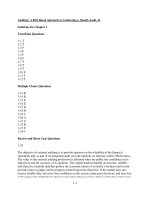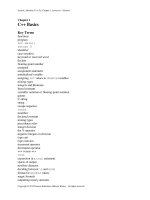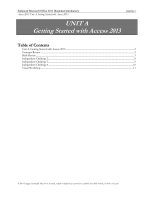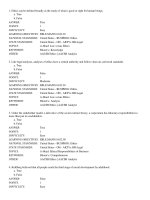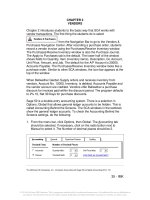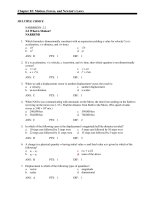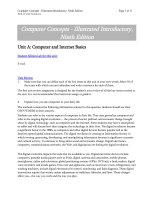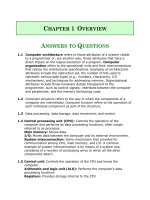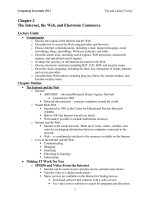Test bank and solution manual of auditing 9e (1)
Bạn đang xem bản rút gọn của tài liệu. Xem và tải ngay bản đầy đủ của tài liệu tại đây (338.09 KB, 18 trang )
Auditing: A Risk Based Approach to Conducting a Quality Audit, 9e
Solutions for Chapter 1
True/False Questions
1-1 T
1-2 T
1-3 F
1-4 F
1-5 F
1-6 F
1-7 T
1-8 T
1-9 T
1-10 F
1-11 T
1-12 T
Multiple Choice Questions
1-13 B
1-14 B
1-15 E
1-16 E
1-17 D
1-18 D
1-19 C
1-20 A
1-21 A
1-22 B
1-23 E
1-24 C
Review and Short Case Questions
1-25
The objective of external auditing is to provide opinions on the reliability of the financial
statements and, as part of an integrated audit, provide opinions on internal control effectiveness.
The value of the external auditing profession is affirmed when the public has confidence in its
objectivity and the accuracy of its opinions. The capital markets depend on accurate, reliable,
and objective (neutral) data that portray the economic nature of an entity’s business and in turn
provide a base to judge current progress toward long-term objectives. If the market does not
receive reliable data, investors lose confidence in the system, make poor decisions, and may lose
© 2014 Cengage Learning. All Rights Reserved. May not be scanned, copied or duplicated, or posted to a publicly accessible website, in whole or in part.
1-1
a great deal of money; ultimately, the system may fail. By providing an independent audit
opinion, the capital markets can be assured that the financial data that they are basing their
decisions upon are accurate.
1-26
The special function performed by the external auditing profession is the attestation to the
fairness of the financial statements of clients. The special function helps ensure the reliability
and integrity of the financial reporting system. The auditing profession exists to serve the users
of an organization's financial statements. These include lenders, investors, management,
government, and (indirectly) all individuals who are ultimately affected by the integrity of the
financial reporting process. Auditors need to remember that they are serving the public interest
and not the interests of client management.
1-27
Audit services are needed because there is a:
Potential bias in providing information.
Remoteness between a user and the organization or trading partner.
Complexity in the transaction, information, or processing systems such that it is difficult to
determine their proper presentation without a review by an independent expert.
Need to limit negative consequences that arise from relying on inaccurate information.
1-28
The audit enhances the quality of financial statements because the user has the assurance that an
independent, qualified professional has examined the financial statements and has rendered an
opinion on their fairness. The independence and expertise of the auditor serve as a quality control
function to overcome the potential bias of management in presenting the financial statements in a
manner that most flatters an assessment of their performance. The audit is designed to add
credibility to the financial statements.
An audit does not necessarily guarantee a fair presentation of a company's financial statements,
although it does dramatically increase the likelihood that there are no material misstatements in
the company's financial statements. The audit provides reasonable, not absolute, assurance about
the accuracy of the financial statements. The caveats about fairness exist for two reasons:
Fairness is judged within a framework of GAAP. Some question whether GAAP results
in the fairest possible presentations when there are significant changes in market values of
investments or assets. For example, the SEC has encouraged financial institutions to move
from using historical cost required by GAAP to market values for all investments in
© 2014 Cengage Learning. All Rights Reserved. May not be scanned, copied or duplicated, or posted to a publicly accessible website, in whole or in part.
1-2
securities because it believes that market value presents a better picture of economic reality
than does historical cost.
Although designed to detect material fraud, it might be possible that a well-executed
audit may still fail to detect fraud.
1-29
Independence means objectivity and freedom from bias. The auditor can favor neither the client
nor the third party in evaluating the fairness of the financial statements. The auditor must be
independent in fact and in appearance. Independence in fact means the auditor is unbiased and
objective. An auditor could be independent in fact if he or she owned a few shares of common
stock in an audit client, but might not appear independent to a third party. Independence in
appearance means that a third party with knowledge of the auditor’s relationship with the client
would consider the auditor to be independent. If users don’t perceive auditors to be independent
then the value of the audit is lacking.
1-30
a.
An organization’s financial statements should reflect a true and fair view of the
organization’s financial results. The statements should not favor one user over another. However,
the interests of the various users can conflict. By having rules that encourage auditor
independence (e.g., not owning stock in the client company, not performing consulting services
for a publicly traded audit client), the profession encourages auditor independence.
b.
Management
Stockholders
Bondholders
Financial Institutions
Taxing Authorities
Regulatory Agencies
Labor Unions
Court System
Vendors
Retired Employees
Review performance, make operational decisions, report results to
capital markets
Buy or sell stock
Buy or sell bonds
Evaluate loan decisions, considering interest rates, terms, and risk
Determine taxable income and tax due
Develop regulations and monitor compliance
Make collective bargaining decisions
Assess the financial position of a company in litigation
Assess credit risk
Protect employees from surprises concerning pensions and other postretirement benefits
1-31
© 2014 Cengage Learning. All Rights Reserved. May not be scanned, copied or duplicated, or posted to a publicly accessible website, in whole or in part.
1-3
a.
Susan Birkert had a friend purchase $5,000 of stock in the company that she was
auditing. She lied to KPMG when responding to the firm’s yearly written requirements to
comply with the firm’s independence policies.
b.
Independence in fact means that while Susan might have actually not behaved in a biased
manner on the engagement because of the stock she owned, external users may perceive an
independence conflict, thus causing the auditor to not be independent in appearance.
c.
The answer to this question will vary by student.
1-32
a. Management may want an independent audit because:
An independent assessment of the fairness of presentation enhances the perceived
reliability of the financial report and assists the company in obtaining loans or new
capital because the investing and lending public will have confidence in the financial
figures.
The auditor's expertise in related areas may help the client in
(a) Tax planning.
(b) Preparing tax returns.
(c) Selecting and implementing accounting information systems.
(d) Identifying sources of capital or loans.
(e) Preparing financial forecasts or analyses that may assist the company in obtaining
loans or new capital.
(f) Determining the efficiency of existing accounting operations.
(g) Observing areas in which efficiency and effectiveness of operations might be
improved.
The auditor's testing and evaluations of controls may provide insights into areas in which
improvements could be made.
The independent assessment and testing of transactions represent a management control
device because individuals know that their work will be tested and evaluated.
The threat, as well as the performance, of an audit may act to deter potential fraud on the
part of employees.
The auditor's expertise may lead to improved financial presentations because of the
application of accounting principles or improved financial statement disclosure.
b. Some of the points that might be discussed by management in determining the nature of the
audit firm to engage to conduct the audit:
The audit fees for conducting the audit.
© 2014 Cengage Learning. All Rights Reserved. May not be scanned, copied or duplicated, or posted to a publicly accessible website, in whole or in part.
1-4
The reputation of the auditor in the community and potential impact of auditor reputation
in securing loans or capital.
The ability of the auditor to assist the firm in expanding the scope of its operations
beyond the immediate geographic area.
The industry-specific knowledge of the potential auditors.
The individual personnel servicing the company, that is, the involvement of a partner
versus other personnel on the engagement.
Perceived audit expertise in ancillary areas such as tax, financial projections and analysis,
mergers and acquisitions, and systems.
The outcome of any recent peer review performed on the audit firm.
The satisfaction of other clients with the level of service obtained from the audit firm.
The ability of the audit firm to use state-of-the art technology on the engagement and to
introduce that technology to the client.
(Note: The above list is not inclusive. Students are generally quite good in identifying other
factors that may or may not be important and thus provide for excellent classroom discussion.)
c. Several users might be interested in Green Day’s financial results, including: management
itself, existing or potential creditors, and potential takeover or merger distributorship partners.
1-33
Primary Parties Involved in Preparing
Audited Financial Statements
Management
Role
Maintains internal controls and prepares
reports
Provides internal assurance on internal
controls and reports
Provides oversight of the reporting process
and other parties
Provides independent audit of internal
controls and financial statements
Internal Auditor
Audit Committee
External Auditor
1-34
There exist various types of audit service providers, and they are each suited to auditing different
types of clients:
Large, multi-national audit firms are best suited to auditing large multi-national
companies, both publicly traded and privately held.
© 2014 Cengage Learning. All Rights Reserved. May not be scanned, copied or duplicated, or posted to a publicly accessible website, in whole or in part.
1-5
Regional audit firms are best suited to auditing relatively small publicly traded companies
or medium sized privately held companies.
Small audit firms are best suited to auditing small privately held companies.
1-35
The requirements of those entering the auditing profession are demanding. Audits are performed
in teams where each auditor is expected to complete tasks requiring considerable technical
knowledge and expertise, along with leadership, teamwork, and professional skills. In terms of
technical knowledge and expertise, auditors must understand accounting and auditing
authoritative literature, develop industry and client-specific knowledge, develop and apply
computer skills, evaluate internal controls, and assess and respond to fraud risk.
In terms of leadership, teamwork, and professional skills, auditors make presentations to
management and audit committee members, exercise logical reasoning, communicate decisions
to users, manage and supervise others by providing meaningful feedback, act with integrity and
ethics, interact in a team environment, collaborate with others, and maintain a professional
personal presence.
1-36
Working in a team
environment
Work specialization
Type of work
Organizational culture
Staff turnover
Larger Audit Firms
multiple teams that
typically disband after
each audit engagement
specialized by
function, i.e., audit or tax
but usually not both
primarily external
audit
relatively formal
relatively higher
Smaller Audit Firms
teams that overlap
across engagements
less specialized by
function, i.e., an
individual may work
across functions and
industries
may include other
assurance services
relatively less formal
relatively lower
1-37
Organization Affecting External
Auditing Profession
a. Congress
b. PCAOB
Nature of Effects
Passed Sarbanes-Oxley Act of 2002
Sets audit standards for auditors of public companies
and regulates and enforces the external audit
profession for auditors of public companies listed on
© 2014 Cengage Learning. All Rights Reserved. May not be scanned, copied or duplicated, or posted to a publicly accessible website, in whole or in part.
1-6
c. SEC
d. AICPA
e. Center for Audit Quality
f. IAASB
g. COSO
U.S. stock exchanges
Regulates and provides enforcement of the capital
market system participants, including external
auditors and public companies; has the authority to
establish GAAP
Sets audit standards for auditors of privately held
companies and administers the CPA exam
Works to enhance investor confidence and trust in
the financial markets; is affiliated with the AICPA
Sets audit standards for auditors of public companies
internationally.
Provides guidance on internal control, enterprise risk
management, and fraud deterrence.
1-38
a)
PCAOB
Sets auditing standards for
audits of public companies
b)
Performs inspections of all
firms that are registered with
it. Note that all firms that
audit public companies are
required to register with the
PCAOB and are inspected by
the PCAOB.
c)
Does not set accounting
standards; this responsibility
is delegated to the FASB and
the SEC.
AICPA
Does not set auditing
standards for the audits of
public firms anymore. It does
set standards for audits of
non-public companies.
Requires peer reviews of
firms enrolled in the AICPA
Peer Review Program to
assess the quality of their
audit practices as it relates to
non-public clients. Thus, a
firm with both public and
non-public clients would be
inspected by the PCAOB and
be required to have a peer
review through the AICPA.
Does not set accounting
standards; this responsibility
is delegated to the FASB and
the SEC.
1-39
a. On the “pro” side, having the same standards makes audits more comparable for the public and
the auditors. Nobody has to go through the trouble of reconciling differences in audits. On the
© 2014 Cengage Learning. All Rights Reserved. May not be scanned, copied or duplicated, or posted to a publicly accessible website, in whole or in part.
1-7
“con” side, standards that seem appropriate for public clients may require more time and effort
than necessary to gain comfort with a non-public company’s financial statements. Auditors
should be able to work in the most efficient way if they are going to be profitable.
b. Examples could include the following: (1) public companies might have auditing standards
that are more applicable to larger and more complex entities, (2) non-public companies might
have auditing standards that adjust for weaker internal controls (e.g., lack of segregation of
duties), (3) public companies might have audit standards that are geared toward more remote and
less-informed users (e.g., shareholders) rather than less remote and better-informed users (e.g.,
bankers).
c. This dual structure can create various difficulties, including the following: (1) the same audit
firm and its auditor employees have to learn and apply different auditing standards, thereby
affecting training costs, (2) there is greater cost to society because multiple standard setters are
operating independently, (3) users may be confused by the different standards of the two
organizations.
1-40
The requirement that no more than two of the PCAOB board members may be CPAs was put
into place to ensure that the Board is not unduly dominated by members of the external audit
profession, thereby helping to assure users of financial statements that this important regulator is
representing the broad interests of users, not just serving the preferences of the external audit
profession.
1-41
Audit quality involves performing an audit in accordance with generally accepted auditing
standards (GAAS) to provide reasonable assurance that the audited financial statements and
related disclosures are presented in accordance with generally accepted accounting principles
(GAAP) and providing assurance that those financial statements are not materially misstated
whether due to errors or fraud. The five elements of the FRC’s Audit Quality Framework
include: (1) audit firm culture, (2) skills and qualities of the audit partner and the engagement
team, (3 effectiveness of the audit process, (4) factors outside the control of auditors, and (5)
reliability and usefulness of audit reporting, including auditor communication of key issues.
1-42
a. Audit firm culture affects audit quality because when it is positive it:
- Creates an environment where achieving quality is valued, invested in and rewarded.
© 2014 Cengage Learning. All Rights Reserved. May not be scanned, copied or duplicated, or posted to a publicly accessible website, in whole or in part.
1-8
- Emphasizes the importance of ‘doing the right thing’ in the public interest and the effect of
doing so on the reputation of both the firm and individual auditors.
-Ensures partners and staff have sufficient time and resources to deal with difficult issues as they
arise.
-Ensures financial considerations do not drive actions and decisions having a negative effect on
audit quality.
-Promotes the merits of consultation on difficult issues and supporting partners in the exercise of
their personal judgment.
-Ensures robust systems for client acceptance and continuation.
-Fosters appraisal and reward systems for partners and staff that promote the personal
characteristics essential to quality auditing.
-Ensures audit quality is monitored within firms and across international networks and
appropriate consequential action is taken.
Expert Skills and Qualities of the Audit Partner and Engagement team affect audit quality
because they:
-Affect whether partners and staff understand their clients’ business and adhere to the principles
underlying auditing and ethical standards.
-Affect the ability of partners and staff to exercise professional skepticism in their work and to
ensure that they are robust in dealing with issues identified during the audit.
-Affect whether staff performing audit work have sufficient experience and are appropriately
supervised by partners and managers.
-Affect whether partners and managers provide junior staff with appropriate ‘mentoring’ and ‘on
the job’ training.
-Affect whether sufficient training is given to audit personnel in audit, accounting and industry
specialist issues.
In turn, these factors affect the effectiveness of the audit process itself, which then has further
effects on audit quality.
b. Factors outside the control of the external auditor include forces such as organizational
corporate governance and the regulatory environment.
c. Users care about audit quality because if audit quality is lacking, then the reliability of the
audited financial statements is questionable. Users that might care more about audit quality are
those with a significant financial stake in the company (e.g., shareholders) or those with
significant money to lose if the company’s financial statements are inaccurate (e.g., bankers or
other lenders).
1-43
© 2014 Cengage Learning. All Rights Reserved. May not be scanned, copied or duplicated, or posted to a publicly accessible website, in whole or in part.
1-9
Independence is vitally important to the auditing profession. Auditors exist to create confidence
in the public that financial statements are free from material misstatement. When auditors are not
independent, the public cannot necessarily trust that the statements are free from material
misstatement, because the public would believe that auditors could have incentives to allow
misstatements. Lack of independence was a primary concern prior to adoption of the SarbanesOxley Act because the auditing profession was rapidly losing the public trust that had taken
decades to build. At the time, the AICPA was aggressively lobbying to ensure that audit firms
could provide both audit and consulting engagements for the same client. Congress saw the need
to begin rebuilding this public trust through legislation, since self-regulation (via the AICPA)
proved inadequate.
1-44
a. Auditor independence requirements include partner rotation rules (five year rotation on public
clients) and prohibition of consulting services for public clients.
b. Review programs include:
external inspections/peer reviews, which include inspections by the PCAOB and peer
reviews by other audit firms facilitated by the AICPA
engagement quality reviews, which involves having an audit partner not otherwise
involved in the engagement review the major issues and evidence prior to the issuance of the
audit report
interoffice reviews, which are reviews of one office of the audit firm by professionals
from another office to assure that the policies and procedures established by the firm are being
followed.
c. Engagement letters state the scope of the work to be done on the audit so that there is no doubt
on the part of the client, auditor, or court system as to the expectations agreed to by the external
auditor and the client.
d. Making appropriate client acceptance/continuance decisions involves avoiding accepting or
retaining high risk clients.
e. Evaluating audit firm limitations means ensuring that an audit firm does not undertake an
engagement that it is not qualified to handle.
f. Audit documentation is required to ensure that all work actually done on the audit is described
in the audit workpapers.
1-45
The seven threats to independence are as follows:
© 2014 Cengage Learning. All Rights Reserved. May not be scanned, copied or duplicated, or posted to a publicly accessible website, in whole or in part.
1-10
1. Self-review threat – occurs when the audit firm also provides non-audit work for the client,
such as preparing source documents used to generate the client’s financial statements.
Independence is threatened because it may appear that the auditor is reviewing his or her own
work.
2. Advocacy threat – occurs when the auditor acts to promote the client’s interests, such as
representing the client in tax court. Independence is threatened because it may appear that the
auditor cares more about the client than external users of the financial statements.
3. Adverse interest threat – occurs when the auditor and the client are in opposition to one
another, such as when either party has initiated litigation against the other. Independence is
threatened because the auditor may take actions that are intended to weaken the client’s
chances in the litigation, and may appear to care more about the audit firm and its interests
rather than those of the company or external users of the financial statements.
4. Familiarity threat – occurs when the auditor has some longstanding relationship with an
important person associated with the client. Examples include:
The audit partner’s close relative is employed in a key position at the client.
The audit partner has been assigned to the client for a long period of time and has developed
very close personal relationships with top management.
A member of the audit team has a close personal friend who is employed in a key position at
the client.
A member of the audit team was recently a director or officer at the client.
In each of these examples, independence is threatened because the auditor may act in a way
that favors the client or individual employed at the client rather than external users of the
financial statements.
5. Undue influence threat – occurs when client management attempts to coerce or provide
excessive influence over the auditor. Examples include:
Top management threatens to replace the auditor or the audit firm because of a disagreement
over an accounting issue.
Top management pressures the auditor to reduce the amount of work they do on the audit in
order to achieve lower audit fees.
An employee of the client gives the auditor a gift that is clearly significant or economically
important to the auditor.
In each of these examples, independence is threatened because the auditor may act in a way
that favors the client or individual employed at the client rather than external users of the
financial statements.
© 2014 Cengage Learning. All Rights Reserved. May not be scanned, copied or duplicated, or posted to a publicly accessible website, in whole or in part.
1-11
6. Financial self-interest threat – occurs when the auditor has a direct financial relationship with
the client, such as owning stock in the client company, owing money to the client company,
or when the audit client makes up the vast majority of the audit firm’s total revenue.
Independence is threatened because the auditor’s judgment may be unduly influenced by
their own financial interests rather than acting in the best interests of external users of the
financial statements.
7. Management participation threat – occurs when the auditor takes on the role of management
or completes functions that management should reasonably complete, such as establishing
internal controls or hiring/firing client employees. Independence is threatened because the
auditor is acting as management, and so would in essence be reviewing his or her own work.
1-46
Safeguards include the following:
1. Safeguards created by the profession or regulation. Examples include:
Education, continuing education, and training requirements
Professional standards and disciplinary punishments
External review of audit firms’ quality control systems
Legislation concerning independence requirements
Audit partner rotation requirements for publicly traded companies, which include mandatory
partner rotation after five years of service
Nonaudit (e.g., consulting) work not allowed for companies for which the auditor provides
external audit work
2. Safeguards created by the audit client. Examples include:
Client personnel with expertise to adequately complete necessary management and
accounting tasks without the involvement or advice of the auditor
Appropriate tone at the top of the client company
Policies and procedures to ensure accurate financial reporting
Policies and procedures to ensure appropriate relationships with audit firm
3. Safeguards created by the audit firm. Examples include:
Audit firm leadership that stresses the importance of independence
Audit firm quality control policies and procedures
Audit firm monitoring processes to detect instances of possible independence violations
Disciplinary mechanisms to promote compliance with independence policies and procedures
Rotation of senior engagement personnel
© 2014 Cengage Learning. All Rights Reserved. May not be scanned, copied or duplicated, or posted to a publicly accessible website, in whole or in part.
1-12
Contemporary and Historical Cases
1-47
a. The objective of external auditing is to provide opinions on the appropriateness of the financial
statements and, as part of an integrated audit, provide opinions on internal control effectiveness.
The capital markets depend on accurate, reliable, and objective (neutral) data that portray the
economic nature of an entity’s business and in turn provide a base to judge current progress
toward long-term objectives. If the market does not receive reliable data, investors lose
confidence in the system.
Forbes failed to exercise due professional care (a standard of care expected to be demonstrated
by a competent auditing professional), failed to exercise professional skepticism (an attitude that
includes a questioning mind and critical assessment of audit evidence), and failed to obtain
sufficient evidence necessary to issue an audit opinion on the financial statements of Alloy
Steel’s 2006 fiscal year end financial statements. The PCAOB also concluded that Bentleys
violated PCAOB quality control standards because the firm did not develop policies to ensure
that the work performed by its personnel met PCAOB auditing standards and that the firm did
not take care to undertake only audits that the firm could reasonably expect to be completed with
professional competence.
b. Alloy Steel requires an independent audit on its financial statements because it is a publicly
traded stock in the U.S., and therefore is required to provide shareholders reliable, independent
assurance on those financial statements.
c. Likely users of Alloy Steel’s financial statements include:
Current and future shareholders and lenders – they were likely adversely affected by
Forbes’ actions because they received an audit report that was signed by an audit firm that did
not actually do the audit work on the engagement. As such, audit quality was lacking and the
reliability of the audit opinion is lacking.
Regulators and Standards Setters – the SEC and the PCAOB were likely adversely
affected because they assume that when a registered audit firm such as Bentley’s performs an
audit they following relevant auditing standards and do not flagrantly violate those standards.
d. The auditors required knowledge of international financial accounting standards and U.S.
auditing standards as adopted by the PCAOB. The auditors that actually completed the audit
work on this engagement were not trained to conduct such an audit, so while they performed
audit procedures those procedures were not necessarily appropriate in providing reasonable
assurance on the financial statements of Alloy. Further, auditors should conduct an audit with an
appropriate level of professional skepticism, which did seem to be the case for this audit.
© 2014 Cengage Learning. All Rights Reserved. May not be scanned, copied or duplicated, or posted to a publicly accessible website, in whole or in part.
1-13
e. The key drivers of audit quality are as follows:
Audit firm culture – Bentley’s culture was obviously inadequate. The Firm should have
ensured that Forbes audit engagement was reviewed. The Firm should have ensured that
supervision was in place and should have ensured that the message of “high audit quality” was
received and acted upon by its personnel.
Skills and qualities of the audit partner and engagement team. The case does not speak to
the skills and qualities of the engagement team because Bentley’s employees, other than Forbes,
were not involved. Rather, the case speaks to the low ethical and professional standards of
Forbes, who knowingly signed an audit report without following any relevant professional
guidance.
Effectiveness of the audit process. This was clearly lacking because Bentley’s personnel
did not conduct the engagement, Forbes did not review or obtain evidence necessary to issue an
audit opinion, and the auditors from the other audit firm that actually conducted the audit tests
were not trained to do so in accordance with U.S. auditing standards.
Factors outside the control of the external auditor – case facts do not speak to this driver
of audit quality.
Reliability and usefulness of audit reporting. This was clearly a sham audit. It does not
provide reliable or useful information for users of the financial statements.
1-48
a. While managers are the individuals actually responsible for the financial statements and they
are the ones actually committing the fraud, auditors are responsible for providing assurance that
those financial statements are not materially misstated. In the case of Enron, the auditors failed to
stand up to management’s aggressive and fraudulent financial reporting, and failed to alert users
about the company’s true financial condition.
b. Independence is important in terms of both fact and in terms of appearance. Duncan did not
violate any independence standards that existed at the time. Andersen had every right to provide
both consulting and audit services to Enron, because professional standards at the time did not
prohibit such activities. Still, when consulting revenues are very high, users may perceive that
the auditor is not independent. In this case, Duncan’s advocacy for Enron’s aggressive
accounting choices leads to the inference that he wished to please Enron management in order to
continue providing the auditing and lucrative consulting services. When this is the perspective of
the auditor, it is easy to see why quality auditing may take a “back seat”.
c. There were many user groups adversely affected by the fraud:
Management and other Enron employees. Those not involved in the fraud lost the value of
their Enron stock holdings, and lost their jobs. Their resumes will be forever tainted by their
association with Enron.
© 2014 Cengage Learning. All Rights Reserved. May not be scanned, copied or duplicated, or posted to a publicly accessible website, in whole or in part.
1-14
Stockholders, bondholders, lending institutions, retired employees, and vendors. Lost the
value of their investments and the collectability of amounts owed to them.
Regulatory Agencies. Lost credibility because they did not “catch” the fraud earlier and did
not adequately monitor the aggressive behaviors of Enron.
Andersen employees. Those not involved in the fraud received a terrible punishment – the
downfall of their employer. Their resumes are tainted by their association with an audit firm
that was found to be acting in a low quality manner.
d. The SEC and federal regulators were likely suspicious of the overall audit quality of Andersen
as an entire firm because of the sequential number of high-profile frauds that revealed audit
failures by Andersen. That, coupled with the document shredding, likely led to the conclusion
that this audit firm needed to be stopped before it continued to act in a low quality manner.
Application Activities
1-49
Answers to this question will vary depending on the date of access to the website. See Auditing
in Practice feature “Who are the Leaders of the PCAOB” for this information as of 2012.
1-50
Answers to this question will vary depending on the date of access to the website.
1-51
Answers to this question will vary depending on the date of access to the website.
1-52
a. The purpose of this exercise is to exhibit the numerous cases brought by the SEC, as well as to
provide the student with practice in understanding and analyzing the cases.
b. The purpose of this exercise is to exhibit the constantly evolving nature of professional
accounting guidance that is provided by the SEC. Many of the recent SABs relate to codification
issues. A more recent SAB that deals with technical accounting issues with which an auditor
should be familiar is SAB 111.
1-53
© 2014 Cengage Learning. All Rights Reserved. May not be scanned, copied or duplicated, or posted to a publicly accessible website, in whole or in part.
1-15
a. The website notes the following:
“The PCAOB is a private sector, nonprofit corporation, created by the Sarbanes-Oxley Act of
2002, to oversee the auditors of companies in order to protect the interests of investors and
further the public interest in the preparation of informative, fair and independent audit reports.”
With respect to its authority to discipline auditors, the website notes:
“The PCAOB has authority to investigate and discipline registered public accounting firms and
persons associated with those firms for noncompliance with the Sarbanes-Oxley Act of 2002, the
rules of the PCAOB and the Securities and Exchange Commission, and other laws, rules, and
professional standards governing the audits of public companies. When violations are found, the
PCAOB can impose appropriate sanctions.”
b. The website indicates:
“The PCAOB enforcement staff conducts informal inquiries as well as formal investigations
that arise from several sources including: PCAOB inspections of registered firms, PCAOB
research and analysis, other regulators, public disclosures of restatements and auditor
changes, news reports, and confidential tips from the public.”
c. There are many instances that the students can point to, all of which relate to the respondents’
audits of American Fiber Green Products, Inc. Some examples include: the audit was not
properly planned, only a few auditing procedures were performed and significant account
balances and transactions were not tested, and documentation was incomplete.
d. The PCAOB registration of the firm was revoked. Further, the individual auditor was barred
from being associated with a registered public accounting firm – basically prohibiting the auditor
from auditing public clients. Most students will agree that the sanctions seem appropriate, and
some students may even argue for additional sanctions (e.g., fines).
Academic Research Case
1-54
a. The issue relates to public accounting career paths that extend beyond the senior manager
level. Specifically, the historically expected partner position is compared to the relatively new
rise of post senior manager (PSM) positions. PSM is used to refer to all salaried titles higher than
senior manager that exclude any equity stake. In practice, titles such as director and principal are
generally used to refer to PSMs.
© 2014 Cengage Learning. All Rights Reserved. May not be scanned, copied or duplicated, or posted to a publicly accessible website, in whole or in part.
1-16
The authors provide information on PSM positions, including titles used for the position,
responsibilities as compared with partners, factors in determining why a PSM track would be
pursued, costs and benefits of the PSM position to the firm, and gender trends.
b. The paper finds that most firms responding to the survey (57%) do have PSM positions, and
they were generally created over the last decade as an alternative to the partner track. Firm
leadership tends to highly influence which path a rising auditor takes. The same PSM title’s
hierarchy varies across separate firms, though even the highest PSM title tends to be viewed as
inferior to partner level.
Even within a specific firm, the same PSM title does not have homogeneous duties. However,
usually the PSMs focus on daily engagement management and staff development, while the
partner’s focus is on new business development. As the partner’s workload increases, the
existence of the PSM position allows him/her to delegate partner-level work into capable hands.
Due to this and other factors, PSMs tend to bill hours that are greater-than-or-equal-to that of
partners.
The PSM position is beneficial to the firm since it encourages talent retention which improves
client service and technical expertise. No specific agreed-upon negative impact of PSM positions
was found, though the survey indicated that at most, PSM positions may “somewhat” divert
candidates with partner potential away from that equity track.
The gender findings suggest that women are highly more likely to be promoted to PSM positions
rather than partner.
c. An understanding of the different career paths’ duties and hierarchy from a source outside of
the firm helps practicing auditors who reach senior manager level better understand which career
path is more personally appealing. This outsider examination helps eliminate the bias of
information that may come from within the firm when a partner or PSM tries to influence the
senior manager in a certain direction through coaching.
For current PSMs, it enhances their understanding of the perceptions of their role from the
viewpoints of outsiders and partners, including any possible inferiority that is implied.
For current partners, a comparison of costs and benefits, as well as gender trends, helps them
make better decisions as they guide the composition of their firms through promotion decisions.
Since the career path is dictated by firm leadership, senior managers interested in partner now
know just how imperative it is to demonstrate exceptional sales talent because they can be easily
coerced into a terminal PSM role if not.
Although the perception of inferiority looms, senior managers that prefer audit work versus
closing sales may actually gravitate towards PSM roles to fulfill personal needs. Since they tend
© 2014 Cengage Learning. All Rights Reserved. May not be scanned, copied or duplicated, or posted to a publicly accessible website, in whole or in part.
1-17
to bill more hours and are delegated partner-level work, the respect for and pride associated with
PSM roles may increase over time as knowledge increases. PSMs might be viewed as making
greater contributions to the audit profession since they’re immersed in doing the actual work,
whereas partners have a sales focus.
Regardless of individual preferences and abilities, the profession may see an increased filing of
gender discrimination lawsuits if women continue to comprise a minority of the partner
positions.
d. A two stage method was used whereby the authors first conducted a survey that solicited
responses from HR Directors employed at the top 100 public accounting firms, as well as the Big
4 firms. The survey results presented are based on 52 respondents. Secondly, structured
interviews were conducted with two senior partners, one with a Big 4 firm and the other with a
large regional firm. The purpose of the interviews was to explore further some of the issues
raised by the survey data.
e. Sample size was a limiting factor, with 52 firms responding, and only 30 of the firms having a
PSM position. With only 19 firms providing responses to questions on gender issues, the gender
findings may be considered somewhat inconclusive. Furthermore, the interviews were conducted
with only two 2 partners. This study is subject to the limitations common in survey research
(e.g., response bias, representativeness of the overall population).
© 2014 Cengage Learning. All Rights Reserved. May not be scanned, copied or duplicated, or posted to a publicly accessible website, in whole or in part.
1-18
